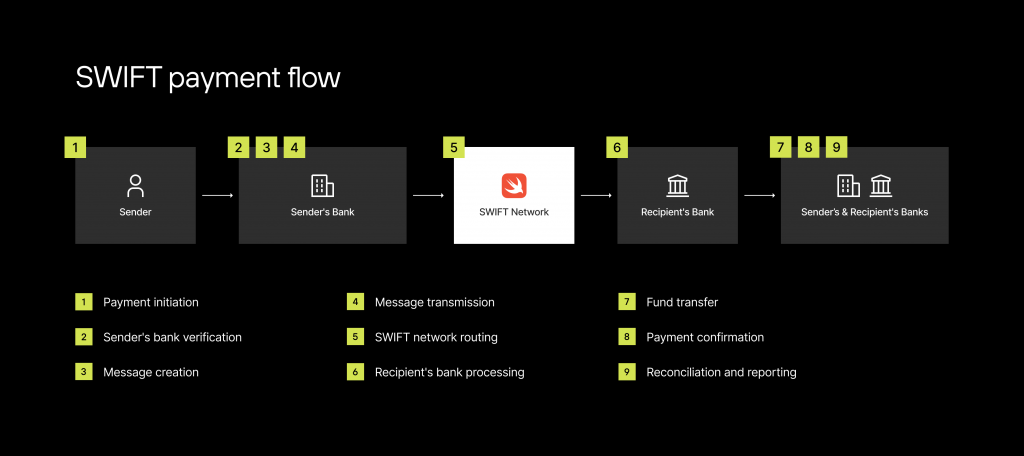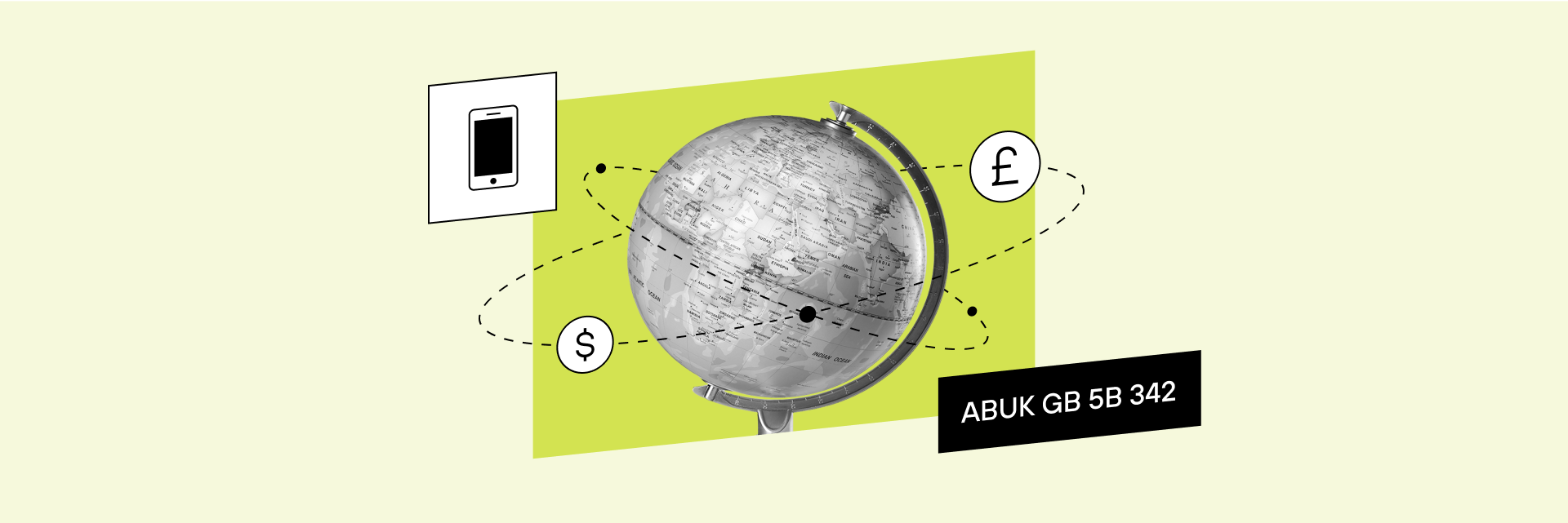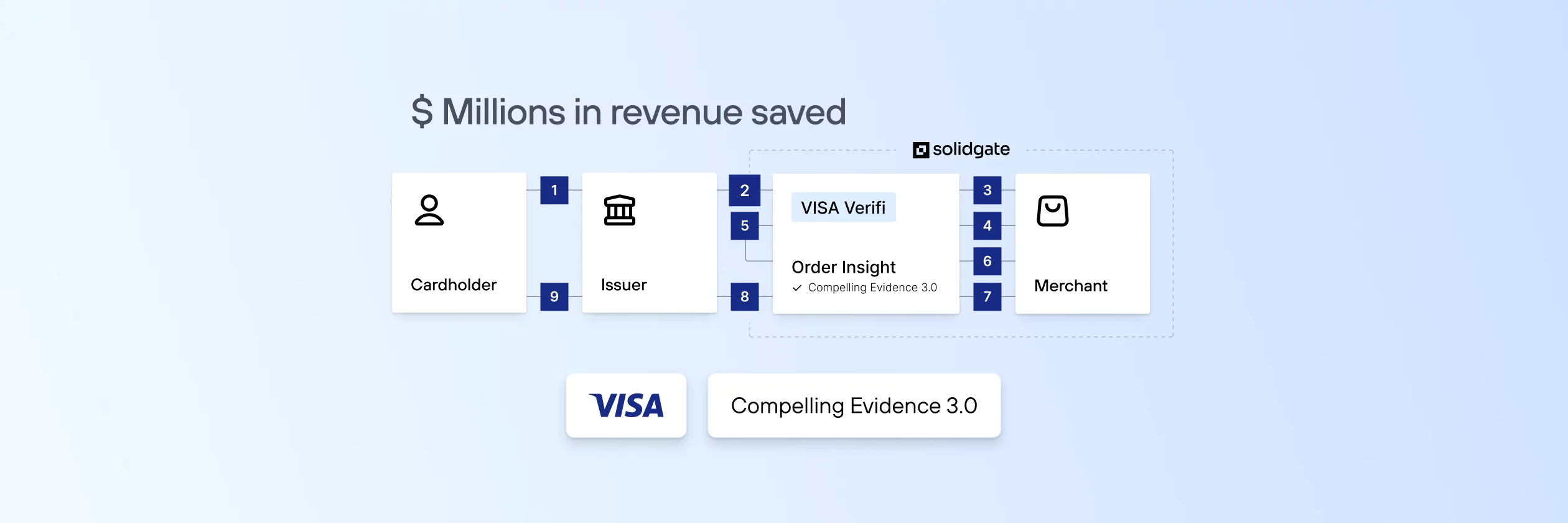44.8 million FIN messages per day are sent via the SWIFT system as financial systems around the world use the network to send everything from payments, securities and treasuries across the globe. SWIFT also known as the Society for Worldwide Interbank Financial Telecommunication, has emerged as a cornerstone of the banking industry, enabling seamless and reliable cross-border transactions. In this comprehensive guide, we will delve into the world of the SWIFT banking system, exploring its functionalities, benefits, and significance in the realm of international payments. Whether you’re seeking to understand the basics of the SWIFT payment system or looking to gain deeper insights into its operations, this article will provide you with a thorough understanding of this critical infrastructure that underpins global financial transactions.
What is the SWIFT banking system? The SWIFT banking system is a global messaging network and financial communication platform used by banks and financial institutions worldwide. It provides a secure and standardized way for financial institutions to exchange information and instructions relating to cross-border payments, treasury operations, securities transactions, and other financial transactions. The SWIFT system enables banks to communicate and settle transactions efficiently, ensuring the secure and reliable transfer of funds across borders. It serves as a crucial infrastructure for international banking, promoting standardization, transparency, and efficiency in global financial transactions.
Table of Contents
Who Benefits from SWIFT and Its Services?
SWIFT’s services benefit a wide range of stakeholders, including banks, corporations, international employees, remittance service providers, regulatory authorities, and the global economy as a whole, by streamlining and securing international financial transactions. Here are some examples:
- Banks and Financial Institutions: SWIFT provides a secure and standardized platform for banks and financial institutions to exchange financial messages and facilitate cross-border transactions. It enables them to streamline their payment processes, reduce operational costs, and enhance efficiency in handling international payments.
- Corporations and Businesses: Corporations and businesses benefit from SWIFT by leveraging its network for secure and efficient treasury operations, cash management, and international trade finance. SWIFT’s services enable them to facilitate payments to suppliers, receive funds from customers, and manage their global financial transactions more effectively.
- International Employees: International employees who work in foreign countries benefit from SWIFT as it enables their employers to easily and securely transfer salaries and other financial benefits to their bank accounts in their home countries. SWIFT ensures timely and reliable fund transfers, allowing international employees to support their families and meet financial obligations across borders.
- Remittance Service Providers: SWIFT’s infrastructure plays a crucial role in facilitating international remittances. Remittance service providers can utilize SWIFT to transfer funds globally, enabling individuals to send money back to their home countries and support their families.
- Regulatory Authorities: SWIFT’s compliance and security measures benefit regulatory authorities by helping them combat financial crimes such as money laundering and terrorist financing. SWIFT’s messaging standards and transparency contribute to the effectiveness of regulatory oversight and enhance the integrity of the global financial system.
SWIFT Payments Step-by-Step Explanation

The SWIFT payments system is an amazing example of financial ingenuity and has played a significant role in facilitating cross-border trade. Here is how typical SWIFT payments work:
- Payment Initiation: The process begins when the sender, typically a bank or financial institution, initiates a payment instruction on behalf of their customer. This instruction includes details such as the beneficiary’s account information, the amount to be transferred, and any additional payment details.
- Sender’s Bank Verification: The sender’s bank verifies the payment instruction, ensuring it meets all necessary regulatory requirements and has the required funds available in the sender’s account.
- Message Creation: Once verified, the sender’s bank creates a payment message using the SWIFT messaging format. This message contains the necessary details of the payment, including the sender’s information, beneficiary information, and payment instructions.
- Message Transmission: The sender’s bank securely transmits the payment message through the SWIFT network to the recipient’s bank. The message is encrypted to ensure data confidentiality and integrity during transmission.
- SWIFT Network Routing: The payment message is routed through the SWIFT network, which acts as a messaging hub, directing the message to the appropriate recipient bank based on the unique SWIFT code assigned to each financial institution.
- Recipient’s Bank Processing: Upon receiving the payment message, the recipient’s bank processes the payment instruction. They verify the beneficiary information, check for any sanctions or compliance issues, and ensure the funds are credited to the correct beneficiary account.
- Fund Transfer: Once the recipient’s bank completes the necessary validations, they initiate the transfer of funds from the sender’s bank to the recipient’s bank. This transfer typically involves corresponding banking relationships and settlement systems to facilitate the movement of funds across borders.
- Payment Confirmation: After the funds have been successfully transferred, both the sender’s and recipient’s banks generate confirmation messages using the SWIFT system. These messages provide proof of payment completion and may include details such as transaction reference numbers and settlement information.
- Reconciliation and Reporting: Both banks reconcile their accounts and update their records to reflect the payment transaction. They generate reports and provide necessary information to their customers regarding the payment status, fees, and other relevant details.
Throughout the entire process, the SWIFT network ensures secure and reliable communication between financial institutions, facilitating efficient cross-border payments while adhering to international standards and regulations.
SWIFT Code and IBAN: What You Need to Know
The SWIFT Code and IBAN are two distinct identifiers used in international banking to facilitate the accurate routing and identification of bank accounts during cross-border transactions. Here’s an explanation of each and how they work:
SWIFT Code:
- The SWIFT Code (also known as the Bank Identifier Code or BIC) is a unique alphanumeric code assigned to each financial institution participating in the SWIFT network.
- It consists of either 8 or 11 characters and is structured in a way that provides information about the bank, its country, city, and branch (if applicable).
- When sending a cross-border payment, the SWIFT Code is used to identify the recipient’s bank and ensure that the payment message is routed to the correct institution.
- It serves as an essential component of the SWIFT messaging system, allowing banks to communicate and process international transactions securely.
IBAN (International Bank Account Number):
- The IBAN is a standardized international numbering system used to identify bank accounts in specific countries.
- It includes a country code, two check digits for data integrity verification, and a series of alphanumeric characters that represent the country-specific bank account number.
- The purpose of the IBAN number is to provide a consistent and internationally recognized format for bank account identification, enabling efficient and error-free cross-border payments.
- The IBAN code is primarily used in European countries and some countries outside Europe that have adopted the IBAN standard.
- When making a payment, the sender must provide the recipient’s IBAN to ensure accurate routing and crediting of funds to the intended bank account.
In practice, when initiating a cross-border payment, the sender’s bank uses the SWIFT Code of the recipient’s bank to route the payment message to the correct institution. The recipient’s bank then uses the IBAN provided by the sender to identify the specific bank account where the funds should be credited. Together, the SWIFT Code and IBAN work in tandem to facilitate accurate and secure international payments, ensuring that funds are transferred to the correct bank and account.
SWIFT’s Additional Services
In addition to its core messaging services, SWIFT offers a range of additional services that further enhance its value as a comprehensive financial infrastructure provider. These services cater to the evolving needs of the global banking community and help streamline operations, promote compliance, and drive innovation. SWIFT’s notable additional services include Compliance Services, Connectivity Services, Global Payments Innovation, SWIFTRef, MyStandards, and the SWIFT Integration Platform.
Compliance Services
SWIFT provides a suite of compliance-related services to assist financial institutions in meeting regulatory requirements and combating financial crime. These services include financial crime compliance solutions, sanctions screening tools, anti-money laundering (AML) controls, and tools for managing counterparty risk. By leveraging SWIFT’s compliance services, institutions can strengthen their risk management and regulatory compliance frameworks.
Connectivity Services
SWIFT’s Connectivity Services offer various options for financial institutions to connect to its secure network. These services provide reliable and secure connectivity through dedicated leased lines, virtual private network (VPN) connections, or cloud-based solutions. Financial institutions can choose the most suitable connectivity option based on their specific needs and operational requirements.
Global Payments Innovation
SWIFT’s Global Payments Innovation initiative aims to enhance the speed, transparency, and end-to-end tracking of cross-border payments. By leveraging gpi, financial institutions can offer their customers faster and more transparent payment services, with features such as same-day value, real-time tracking, and confirmation of payment delivery. The gpi initiative is continually evolving to meet the changing demands of the global payments landscape.
SWIFTRef
SWIFTRef is a comprehensive reference data platform that provides accurate and up-to-date information on financial institutions, payment routing codes, and other essential reference data. It helps financial institutions ensure the accuracy of payment instructions, improve straight-through processing, and minimize errors in payment transactions.
MyStandards
SWIFT MyStandards is a collaborative platform provided by SWIFT that enables financial institutions to streamline and standardize their message standards and implementation processes. It offers tools for message validation, testing, and documentation, allowing institutions to define and manage their message standards efficiently. This promotes interoperability, reduces implementation time, and ensures compliance with SWIFT message standards.
SWIFT Integration Platform
The SWIFT Integration Platform helps financial institutions integrate their internal systems and applications with the SWIFT network. It provides a standardized interface and set of tools to enable seamless integration and data exchange between internal systems and SWIFT messaging infrastructure. This facilitates straight-through processing and simplifies connectivity between financial institutions and the SWIFT network.
How SWIFT Empowers International Employees
SWIFT international payment systems play a significant role in empowering international employees by facilitating secure and efficient cross-border financial transactions. Here are some ways in which SWIFT empowers international employees:
- Global Payment Facilitation: SWIFT enables international employees to receive their salaries, bonuses, and other financial benefits from their employers located in different countries.
- International Remittances: Many international employees work in foreign countries and regularly send money back home to support their families. SWIFT provides a robust infrastructure for remittance service providers to transfer funds internationally, ensuring that the money reaches the recipients quickly and securely.
- Currency Exchange: International employees often need to exchange currencies for various purposes, such as managing expenses in different countries or remitting funds in their local currency. SWIFT enables banks and foreign exchange providers to exchange currencies smoothly, ensuring fair exchange rates and transparent transactions.
- Secure Financial Communication: SWIFT offers a secure messaging network that enables financial institutions to communicate and exchange sensitive financial information. This ensures that international employees’ financial data, transaction details, and personal information remain confidential and protected during cross-border transactions.
- Compliance and Regulation: SWIFT adheres to global standards and regulations, such as anti-money laundering (AML) and know-your-customer (KYC) requirements. SWIFT provides international employees with peace of mind, knowing that their financial transactions are conducted through a trusted and regulated system.
Overall, SWIFT empowers international employees by enabling seamless, secure, and efficient cross-border financial transactions. It supports their financial needs, promotes financial inclusion, and enhances the global mobility of the workforce.
Securing Your Transactions
SWIFT ensures security in its network and transactions through various measures:
- Closed Network: SWIFT operates a private, closed network that is separate from the public internet. This isolation helps prevent unauthorized access and reduces the exposure to external threats.
- Message Encryption: All messages transmitted through the SWIFT network are encrypted using industry-standard encryption algorithms. Encryption ensures that the contents of the messages remain confidential and can only be deciphered by the intended recipients.
- Digital Signatures: SWIFT employs digital signatures to verify the authenticity and integrity of messages. Digital signatures use cryptographic techniques to ensure that messages are not tampered with during transmission and can be verified as originating from trusted sources.
- Strong Authentication: SWIFT requires strong authentication for access to its network and messaging services. This typically includes the use of two-factor authentication, which combines something the user knows (such as a pass
Exploring Alternatives to SWIFT
There is a serious lack of alternatives to SWIFT which is why the network is so powerful. Current alternatives which are either in their infancy or plagued by problems include:
- Blockchain-based Solutions: Blockchain technology has introduced various alternatives to traditional cross-border payments. Platforms like Stellar, Ethereum, and Bitcoin offer decentralized and transparent payment networks that enable peer-to-peer transactions without the need for intermediaries.
- National Payment Systems: Some countries have developed their own domestic payment systems to facilitate cross-border transactions within their regions. Examples include China’s Cross-Border Interbank Payment System (CIPS) and Russia’s Mir Payment System.
- Correspondent Banking Networks: Correspondent banking networks provide a framework for financial institutions to establish direct relationships with partner banks around the world. This allows for direct cross-border payment instructions and reduces dependency on centralized messaging systems like SWIFT.
The Costs and Downsides
While SWIFT provides valuable services for international financial transactions, it’s important to consider the costs and downsides associated with its usage. Here are some factors to consider:
- Cost of Messaging: SWIFT charges fees for messaging services based on message volume, type, and service level. These costs can vary depending on the number of messages exchanged and the specific services utilized. Financial institutions need to account for these expenses when using SWIFT for their cross-border transactions.
- Operational Complexity: Working with the SWIFT system requires technical expertise and operational capabilities. Financial institutions need to ensure that their staff members are trained to handle SWIFT-related processes, including message formatting, compliance, and troubleshooting. This can result in additional training and staffing costs.
- Dependency on Intermediaries: SWIFT relies on correspondent banking relationships and intermediaries to facilitate cross-border transactions. This can introduce additional costs, such as correspondent banking fees, foreign exchange fees, and potential delays in payment processing due to multiple parties involved in the transaction.
- Limited Transaction Visibility: SWIFT messages primarily provide information related to payment instructions, but they may not offer real-time transaction tracking or detailed payment status updates. This lack of transparency can lead to challenges in tracking payments and obtaining up-to-date information on the progress of transactions.
- Security and Fraud Risks: While SWIFT has implemented security measures to protect its network, cyber threats and fraud attempts targeting the SWIFT system have been reported in the past.
It’s important for financial institutions to weigh the costs and downsides of using SWIFT against the benefits and consider alternative payment methods or service providers that may better suit their specific needs and cost considerations.
Understanding How SWIFT Generates Revenue
SWIFT generates revenue through various sources, primarily by providing services and charging fees to its member financial institutions. Here are some key revenue streams for SWIFT:
- Messaging Fees: SWIFT charges fees for the exchange of financial messages between member institutions. Financial institutions pay based on the volume of messages transmitted or received. The fees can vary depending on factors such as message type, volume, and the level of service required.
- Connectivity + Membership Fees: SWIFT offers different connectivity options for financial institutions to access its network. These options include dedicated leased lines, virtual private network (VPN) connections, or cloud-based connections.
- Software and Infrastructure: SWIFT provides software solutions, messaging interfaces, and infrastructure components to its members. Financial institutions pay for licenses, software upgrades, maintenance, and support services provided by SWIFT.
- Security and Compliance Services: SWIFT offers additional security and compliance-related services to help financial institutions meet regulatory requirements and enhance their cybersecurity. These services include fraud prevention tools, payment screening services, and security controls. SWIFT charges fees for these services based on usage and the level of support required.
- Data and Analytics: SWIFT also provides data and analytics services, offering insights and reports based on the vast amount of transactional data flowing through its network. Financial institutions can access this data to gain market insights, monitor payment flows, and enhance their risk management capabilities. SWIFT charges fees for data access and analytics services.
- Training and Certification: SWIFT offers training programs and certifications to help financial institutions improve their knowledge and expertise in using the SWIFT system effectively. Participants pay fees for attending training sessions, and workshops, and obtaining certifications.
- Other Services: SWIFT may generate revenue from other services such as consulting, advisory services, and customized solutions tailored to the specific needs of member institutions.
It’s important to note that SWIFT is a cooperative society, and any surplus revenue generated is reinvested into the organization to support the development and maintenance of its network, infrastructure, and services.
Streamlining Your Payments
The SWIFT system serves as a critical foundation for secure and efficient global payments. By providing a standardized messaging network, SWIFT streamlines payments by ensuring accurate and timely fund transfers across borders. This not only empowers international employees to receive salaries and send money back home with ease but also enhances financial inclusion and supports the global mobility of the workforce. With its robust infrastructure and adherence to regulatory standards, SWIFT continues to play a pivotal role in streamlining and enhancing the efficiency of cross-border payments, contributing to the growth and interconnectedness of the global economy.
FAQs About SWIFT Payments
Who controls SWIFT?
SWIFT is governed and controlled by its member financial institutions, which include banks, broker-dealers, and other financial entities. The organization operates under the supervision of its Board of Directors, which consists of representatives from its member institutions, ensuring a collective decision-making process.
Who pays SWIFT charges?
The charges imposed by SWIFT are typically paid by the financial institutions that utilize its services. These charges are incurred by the sender or receiver of SWIFT messages, depending on the specific transaction. Financial institutions pass on these costs to their customers or account holders as part of their overall transactional fees or service charges.
How do I get paid with SWIFT global payments?
To get paid with SWIFT, provide your payor with your bank account details, including your bank’s SWIFT code and your International Bank Account Number (IBAN). The payor will initiate a SWIFT payment from their bank, which will be transmitted securely through the SWIFT network to your bank account, ensuring the funds are deposited into your account.
Are there alternatives to SWIFT payments?
Current alternatives to SWIFT payments include blockchain networks like Ethereum and Bitcoin, an international money transfer service like Wise which can process some transactions without SWIFT, and SWIFT copycats like China’s Cross-Border Interbank Payment System (CIPS).




